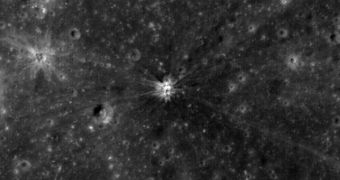NASA's Lunar Reconnaissance Orbiter (LRO) spacecraft recently photographed the impact crater left behind by the upper stage of the Saturn IVB delivery system that the space agency intentionally crashed on the lunar surface on February 4, 1971. The reason why the deorbiting took place was for scientists to get a glimpse of the internal structure of the Moon. The rocket stage's energy created a series of tremors in the surface that was recorded with seismographs set in place by Apollo 12 astronauts, back in 1969. The distinctive crater is about 35 meters (115 feet) in diameter.
The observations were made using the spacecraft's Lunar Reconnaissance Orbiter Camera (LROC), which consists of a pair of narrow-angle cameras (NAC), alongside a single, wide-angle camera (WAC). The high-resolution instrument was specifically designed to be able to detect traces of equipment previously left on the Moon by Apollo astronauts, to photograph landing sites, and to provide further certification of the fact that NASA, indeed, landed on the Earth's natural satellite. LRO will make several flybys over Apollo landing areas, at a height of about 31 miles (50 kilometers).
The new image reveals a rather deep crater, laden with bright mounds. An ejecta blanket is clearly visible in the images, as it surrounds the edges of the crater. It represents the debris that was kicked up in the lunar atmosphere as the massive Atlas upper stage slammed into the Moon at 5,682 miles per hour, or 9.144 kilometers per hour. An area about 1.5 kilometers (0.9 miles) around the impact zone is laden with debris. Because the Sun was high up on the sky when the image was taken, a large number of features can be clearly seen in the photograph, experts at the NASA Jet Propulsion Laboratory say.
According to NASA documents, the energy at which Atlas IVB impacted the Moon was roughly equivalent to ten tons of TNT exploding. The upper stage weighed about 30,835 lbs, and caused small tremors in the surface that lasted for about three hours. Apollo 12-installed seismic instruments were able to pick up the vibrations, and sent them back to the Earth, where scientists inferred numerous characteristics of the lunar soil, PhysOrg reports.

 14 DAY TRIAL //
14 DAY TRIAL //